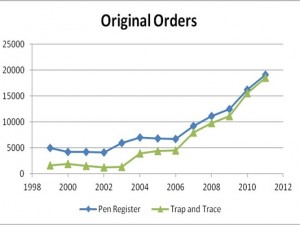I wrote earlier this week about James Ladd, the murderer who recently escaped from a North Carolina prison. Well, he’s been caught, apparently without much fuss: a motorist saw a man running from some woods towards a house and called the authorities, who went to the house and found Ladd crouched in the garage.
In other news:
- Apple recently introduced its iPhone 5, and it seems that it has sparked a deluge of Apple-related crime . . . or maybe just new stories about the same. The News and Observer had this article about the Raleigh IT specialist whose Macbook Air was stolen while he was on his honeymoon – he had tracking software installed and was able to advice the police of its location and supply them with photos, taken by the computer’s webcam, of the thief using it. Meanwhile, ABC has this story about journalists who used Apple’s “Find My Phone” service to track a stolen iPad to the home of a TSA officer, who was captured on film handling the device at the airport. (Make that former TSA officer.) So, are Apple products magnets for theft? Perhaps so, according to this report, which concludes that thefts of Apple devices constitutes 14% of all reported crime in New York City. Maybe I should switch to Android!
- Staying with the digital theme, check out this WSJ Law Blog entry about the rise of certain types of electronic surveillance orders. I may have more to say about the details in a later post, but this graphic gives you the flavor:

- Moving from technology to science, the Washington Post reports here that “The FBI’s crime lab has reduced its backlog of forensic DNA cases by 87 percent over the course of two years,” according to the DOJ’s Inspector General. In a possible indicator of what would help our own State Crime Lab address its backlog, the report attributed the improvement to more staffing and increased automation.
- The United States Supreme Court has recently agreed to review Missouri v. McNeely, covered here by SCOTUSBlog. The issue is: “Whether a law enforcement officer may obtain a nonconsensual and warrantless blood sample from a drunk driver under the exigent circumstances exception to the Fourth Amendment warrant requirement based upon the natural dissipation of alcohol in the bloodstream.” Potentially a pretty big deal.
- Finally, the Los Angeles Times has this story about California’s use of solitary confinement. Some of the facts noted in the article aren’t all that shocking: prisoners in solitary confinement are housed in 7x12 cells, larger than international standards suggest, and they have 90 minutes per day in an exercise yard. On the other hand, I found some of the facts to be very troubling: prisoners ordered to solitary confinement spend an average of 6.8 years there, and “[w]hile isolated prisoners make up about 2% of the total inmate population, they accounted for 42% of [inmate] suicides.” Corrections officials argue that isolation is necessary to control violence and gang activity. My impression is that segregation in North Carolina is used only as a relatively short-term disciplinary tool, but I don’t really know. If you do, please weigh in.
Public Officials - Courts and Judicial Administration Roles
Topics - Courts and Judicial Administration



